Shuruchi Shangha
As I said, Shuruchi Shangha was this year's best pandal, according to the award team. Unfortunately, when we finally made it to the pandal, we'd been there for all of three minutes before it started pouring rain. Unlike in the US, when it pours rain in India, it means business. I was soaked within three minutes and entirely abandoned my umbrella to focus on saving my camera from getting soaked. I never did entirely dry. The only plus side of this is that the line literally evaporated; what would've been a two or three hour waiting period became a ten minute mad dash through mud puddles.
Once we reached the pandal, it was quite nice; still raining, but not so bad that I couldn't risk taking out my camera for a few shots. The pandal was gorgeous. It was split into a variety of structures, only one of which held the idol. Like so many other pandals this year, the pandal was based on South Indian architecture and artwork; unlike others, however, Shuruchi Shangha's pandal was built to resemble a south indian village. Almost all the buildings were crammed with pandal hoppers who were trying to avoid the rain, so I didn't get as close of a look at them as I would've liked.
The idol's building had elaborate artwork on the ceiling and walls. I'm not sure if it was hand-painted or printed -- the lines were so crisp that they look computer-designed rather than painted. The idol itself was another post-modern affair, with a moderately sized, heavily styled Durga who I thought looked vaguely androgynous. The other gods were much smaller than in most pandals, which was an interesting design decision. I wish I could've gotten a better look at it, but the guards forced us through and, just as with Telengabagan, yelled at me for taking pictures. As usual, I put on my best deaf American face and proceeded to take pictures anyways, but we hurried out before they remembered English. In summary, the pandal was very nice, but I'm not sure if it was the best I saw.
Prize: Most ambitious pandal.
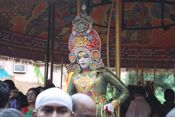 | 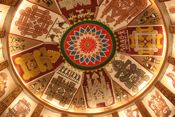 | 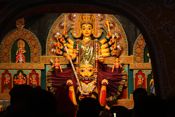 |
Behala Club Sarbojonin
After trying to dry off from Shuruchi Sangha, we decided to head towards Behala to see the pandals there. Our first stop was Behala Club Sarbojonin (Sarbojonin means a club that's open to everyone), which was almost completely deserted due probably to its proximity to Shuruchi Sangha and the rain. I'm not entirely sure what sort of artwork they were aiming for in this pandal, but they executed it very well. The pandal had a long hallway, adorned with metal-painted models of tridents and spears, followed by a small courtyard. The courtyard had a large fountain shaped statue that was the centerpiece of the pandal, right in front of the idols. Since the pandal was mostly deserted, I took quite a few pictures of the artwork here, and it was hard to narrow down to just a few pictures. The idol continued the motif of metal-colored statues, with a vaguely bronzed look to all the idols. The idol at this pandal was one of my favorites of the pujo, due mostly to the lack of gaudy decorations and the seamless integration of color with the rest of the artwork.
Prize: Best metallic artwork.
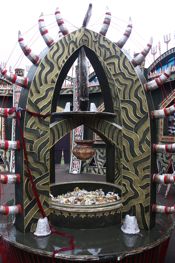 | 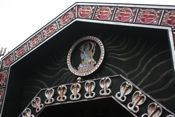 | 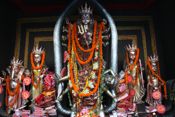 |
Naskar Sarbojonin
Our next pandal, also located in Behala, was Naskar Sarbojonin. This pandal was made entirely out of painted bamboo, and the artwork had a vaguely African look to it (at least, to my eyes). The artwork here was incredible, and again, because of the rain, we had the pandal largely to ourselves. Throughout the pandal, they had a variety of extremely elaborate statues (made from painted bamboo) of people, horses, deer, trees, and more. I loved the general feel of the statuary in this pandal, particularly the horses, and the colors they chose for the bamboo artwork. The idol for this pandal was housed in a 'chariot,' drawn by the horse statues. Although the idol wasn't that fancy, the chariot concept was pretty neat.
Prize: Best statues.
 | 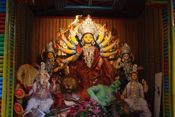 |  |
Behala Natun Sangha
The final pandal we visited on Nabomi was Behala Natun Sangha. This pandal was in a more traditional style, with the pandal serving more as a house for the idol and less as an art exhibit. That being said, the house was still somewhat artistically decorated, but in less of a manner than Naskar Sarbojonin or Behala Club. The pillars and stairs in the pandal were decorated with paint dribbles, which vaguely reminded me of abstract american artwork -- I'm not sure if that was the intent with the style. Inside, the idol was one of the more shiny ones we saw during the pujo, with all the deities equipped with gigantic headdresses. At the entrance, they had a pair of statues of people welcoming guests to the pandal, which was a nice touch.
Prize: Most Jackson Pollack.
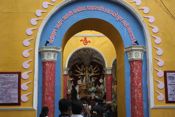 |  | 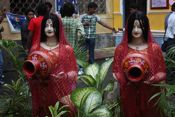 |
No comments:
Post a Comment